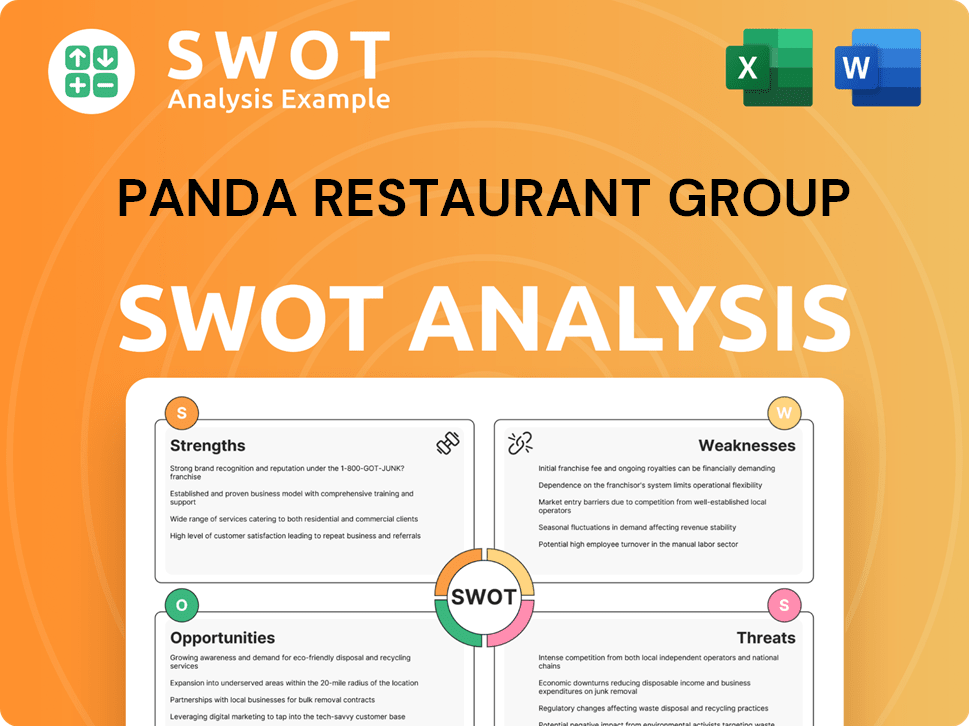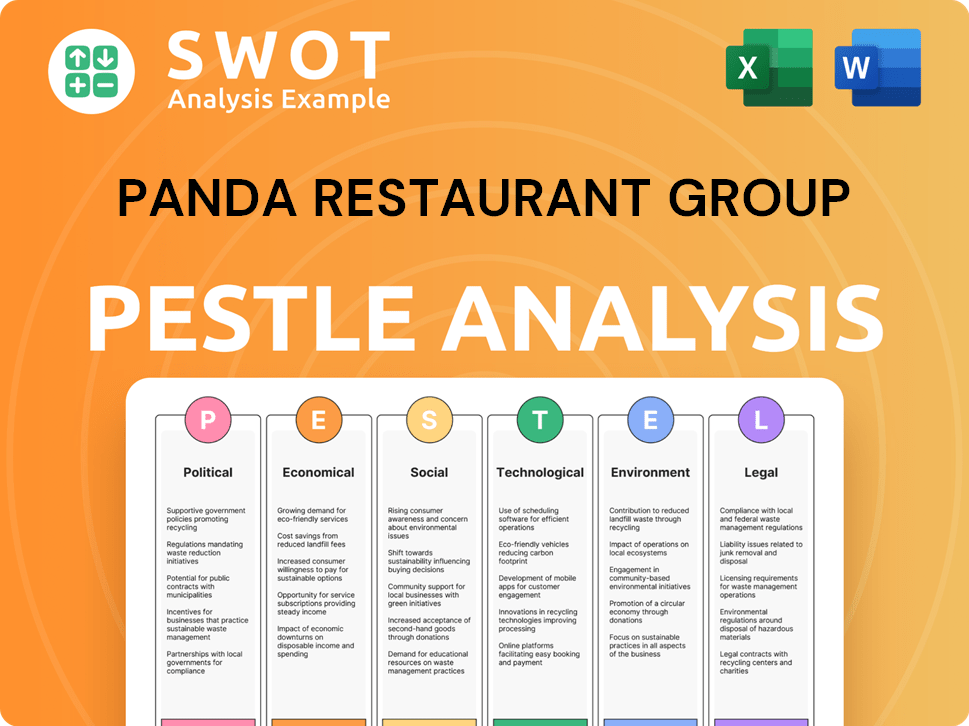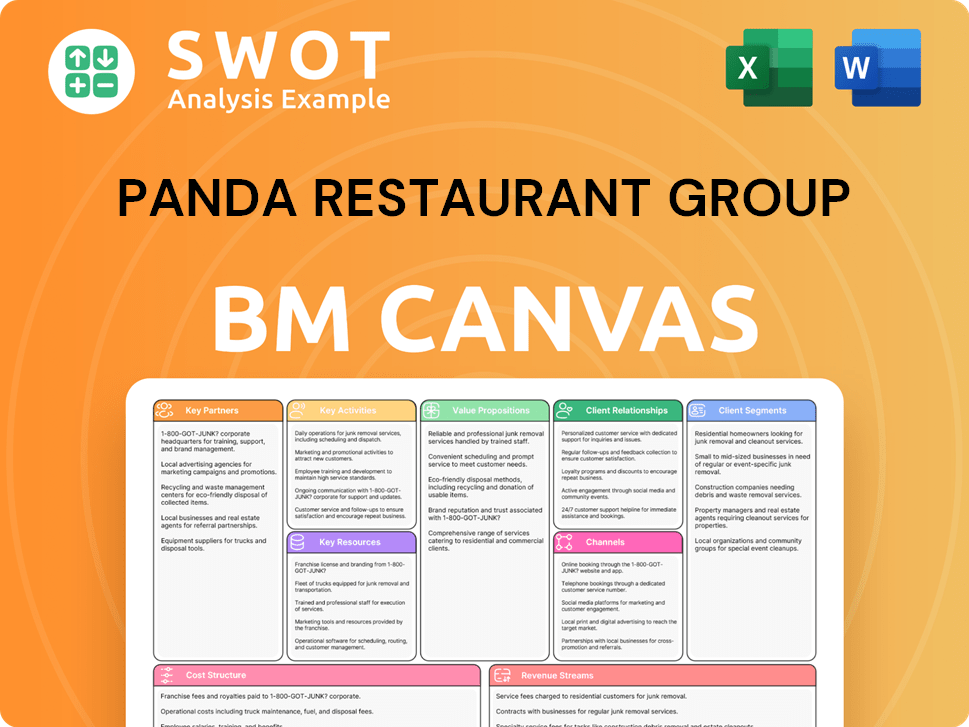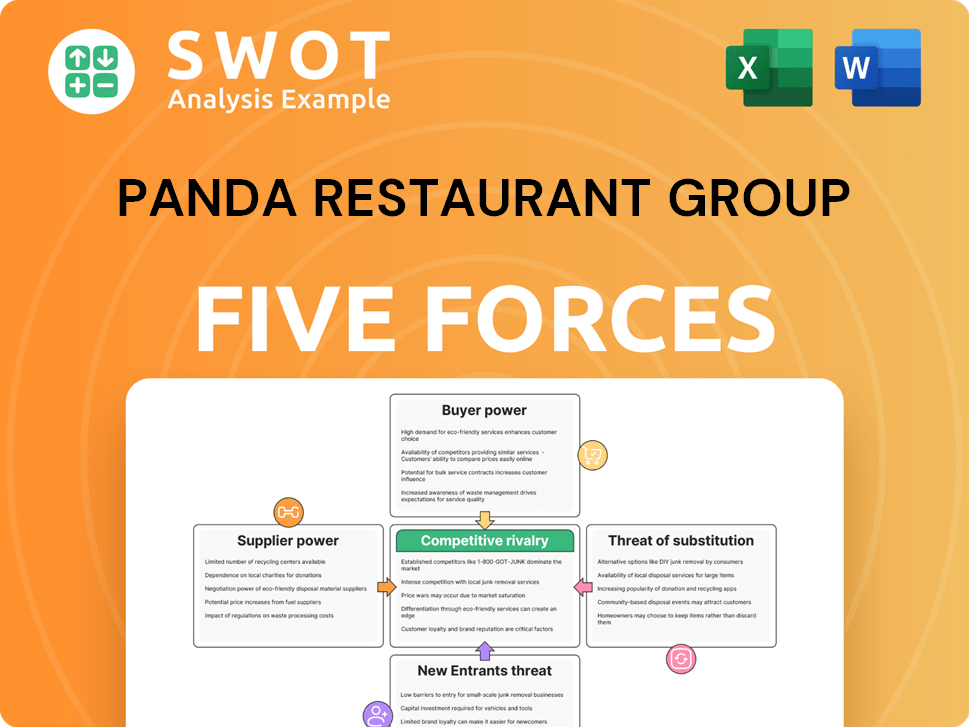Panda Restaurant Group Bundle
How Does Panda Restaurant Group Dominate the Fast-Casual Market?
Discover how Panda Express, a leading name in the fast-food industry, has carved a niche through its innovative Panda Restaurant Group SWOT Analysis, strategic menu development, and robust digital presence. From its humble beginnings in California to its global footprint, Panda Express has consistently adapted to consumer preferences and market trends. Explore the secrets behind their success, from the introduction of the 'Hot Orange Chicken' to their expansive sales channels.

This article will unpack the Panda Restaurant Group Sales Strategy, analyzing the Panda Express Marketing Plan that fuels its growth. We'll examine the Panda Restaurant Company Strategy, including its effective use of Restaurant Marketing techniques and the evolution of the Panda Express Brand. Learn how they've built a loyal customer base through savvy Sales and Marketing initiatives and a deep understanding of their target audience demographics, ensuring continued market share analysis and competitive advantage.
How Does Panda Restaurant Group Reach Its Customers?
The sales strategy of the Panda Restaurant Group, which includes the popular Panda Express brand, relies on a multifaceted approach. This strategy incorporates both traditional and modern sales channels to maximize its reach to customers. The company has strategically developed its sales channels to ensure accessibility and convenience for its customers.
As of late 2024, the company's primary sales channels include a vast network of physical restaurant locations, an e-commerce platform, and strategic partnerships. This integrated approach allows the company to cater to a wide range of consumer preferences and behaviors. The company's strategy is dynamic, adapting to changing consumer habits and market trends.
The company's physical presence is a cornerstone of its sales strategy. The restaurant chain had 2,458 locations in the United States as of October 2024. By the end of 2024, the total restaurant count reached 2,502, with plans for an additional 123 company-owned and 14 franchised stores in 2025, marking its most significant single-year increase in over a decade. The physical locations are strategically placed to capture diverse consumer segments.
Initially, the company focused on high-traffic locations like shopping mall food courts. Over time, the company expanded to include stand-alone restaurants, university campuses, airports, and military bases. This expansion strategy has allowed the company to reach a wider audience and increase its market share.
Digital channels are increasingly vital for the company. The company uses its website and mobile app for online ordering, which is especially important for locations without drive-thrus. The company has also engaged in strategic partnerships, such as collaborations with gaming companies like NRG, emphasizing the social aspect of dining.
The company leverages its website and mobile app for online ordering. The company also utilizes third-party platforms for delivery services. These digital channels enhance customer convenience and accessibility.
The company's expansion includes stand-alone restaurants, university campuses, airports, and military bases. This diversification allows the company to capture a wider range of consumer occasions and demographics. The company's growth strategy is detailed in Growth Strategy of Panda Restaurant Group.
The company's sales strategy is built on a strong foundation of physical locations, digital platforms, and strategic partnerships. This integrated approach allows the company to adapt to changing consumer behaviors and market trends.
- Physical Restaurant Locations: A vast network of restaurants in diverse locations.
- E-commerce Platform: Online ordering through the company website and mobile app.
- Strategic Partnerships: Collaborations for broader distribution and customer engagement.
- Digital Emphasis: Focus on mobile app performance and third-party delivery services.
Panda Restaurant Group SWOT Analysis
- Complete SWOT Breakdown
- Fully Customizable
- Editable in Excel & Word
- Professional Formatting
- Investor-Ready Format

What Marketing Tactics Does Panda Restaurant Group Use?
The marketing tactics employed by Panda Restaurant Group, focusing on Panda Express, are a blend of digital innovation and traditional methods. This approach aims to build brand awareness, stimulate demand, and ultimately drive sales. The company's strategy is data-driven, utilizing customer segmentation to tailor advertising campaigns effectively.
Digital marketing is a cornerstone of their strategy, with a strong emphasis on social media platforms. These channels are used to engage customers, showcase creative content, and direct traffic to their locations. Content marketing highlights menu items and the unique blend of Chinese and American cuisines.
While digital strategies are prominent, traditional media still plays a role in their marketing mix. The company also invests in digital signage and menu boards within its restaurants to improve marketing efficiency. This comprehensive approach helps Panda Express maintain a strong market presence.
Panda Express heavily utilizes social media platforms like Instagram, Facebook, Twitter, and TikTok. They engage with customers, showcase creative content, and drive traffic to their locations. Their digital strategy is a key component of their overall Growth Strategy of Panda Restaurant Group.
Content marketing highlights menu items, fresh ingredients, and the unique blend of Chinese and American cuisines. This strategy keeps customers informed and engaged with the brand. The company ensures its content is appealing and relevant to its target audience.
Data-driven marketing is integral, with customer segmentation used to tailor advertising campaigns. This allows for more targeted and effective marketing efforts. The company aims to reach specific demographics with relevant messaging.
Panda Express targets individuals aged 18-45 with middle to upper incomes who enjoy Chinese fast food. The company also appeals to those with active lifestyles and family-oriented values. This segmentation helps refine their marketing efforts.
Email marketing is a significant conversion channel, with personalized content and consistent campaign frequency. This approach helps maintain interest and loyalty without oversaturating subscribers. The focus is on providing value to customers.
Traditional media, including TV, print, and out-of-home advertising, still plays a role in their marketing mix. This helps ensure a broad reach and consistent brand messaging. The company uses a balanced approach to reach its target audience.
Panda Express has demonstrated innovation by experimenting with new flavors and spices, such as 'Hot Orange Chicken' and 'Chili Crisp Shrimp,' and reintroducing popular items like 'Firecracker Shrimp.' They also leverage user-generated content by encouraging customers to share their experiences on social media, building trust and credibility through authentic feedback. The company's digital marketing efforts have led to significant results; for instance, their short-form video content strategy across various platforms has achieved over 1 billion impressions and a 25% restaurant sales lift in specific locations.
Panda Express employs a variety of marketing tactics to reach its target audience and drive sales. These tactics are designed to create brand awareness and encourage customer engagement.
- Social Media Advertising: Utilizes platforms like Instagram, Facebook, Twitter, and TikTok to engage customers and showcase content.
- Content Marketing: Focuses on menu items, ingredients, and the unique blend of cuisines.
- Data-Driven Marketing: Employs customer segmentation to tailor advertising campaigns.
- Email Marketing: Uses personalized content and consistent campaigns to maintain customer interest.
- Traditional Media: Integrates TV, print, and out-of-home advertising.
- Digital Signage: Uses in-restaurant digital signage and menu boards.
Panda Restaurant Group PESTLE Analysis
- Covers All 6 PESTLE Categories
- No Research Needed – Save Hours of Work
- Built by Experts, Trusted by Consultants
- Instant Download, Ready to Use
- 100% Editable, Fully Customizable

How Is Panda Restaurant Group Positioned in the Market?
The Panda Restaurant Group Sales Strategy centers on solidifying its position as the premier American Chinese fast-food chain. Its brand positioning emphasizes delivering 'exceptional Asian dining experiences' by merging Chinese and American culinary styles. This approach includes a focus on quality ingredients and freshness, which is a key differentiator in the fast-food market.
Panda Express's visual identity, including its logo and overall tone, is designed to be approachable and family-friendly, appealing to a broad audience. The brand promises convenience, affordability, and a pleasant dining atmosphere. The company strategically positions itself as a leader in American Chinese cuisine, aiming to introduce cultural elements through its food offerings.
The company's marketing strategy is designed to resonate with its target demographic, which includes individuals aged 18-45 with middle to upper incomes. The iconic Orange Chicken, which accounted for approximately 30% of all orders in 2024, exemplifies this focus on popular, innovative dishes. Brand consistency across all channels, from in-store displays to social media, is a key component of maintaining a strong brand presence.
Panda Express has cultivated a strong brand identity, focusing on 'exceptional Asian dining experiences'. The brand emphasizes quality and freshness, with a commitment to using fresh ingredients and offering innovative dishes.
The company's marketing strategy targets individuals aged 18-45 with middle to upper incomes. This includes advertising and promotions, digital marketing, and customer engagement initiatives. Panda Express utilizes digital menu boards and social media to maintain brand consistency.
Sales and marketing efforts are designed to boost the brand's market share. The company focuses on customer satisfaction and leverages data to understand consumer preferences. Panda Express's '2024 Theme: Deliver Exceptional Experiences' highlights its dedication to customer satisfaction.
The marketing plan includes menu innovations, like plant-based options, to meet changing consumer demands. It involves continuous efforts to differentiate itself from competitors. The company maintains a strong market presence, with estimated revenue exceeding $3.5 billion in 2024.
Panda Restaurant Group Business Model Canvas
- Complete 9-Block Business Model Canvas
- Effortlessly Communicate Your Business Strategy
- Investor-Ready BMC Format
- 100% Editable and Customizable
- Clear and Structured Layout

What Are Panda Restaurant Group’s Most Notable Campaigns?
The success of the Panda Restaurant Group Sales Strategy hinges on impactful sales and marketing campaigns. These initiatives are designed to boost brand visibility, drive customer engagement, and ultimately, increase sales. By focusing on innovation, customer preferences, and strategic partnerships, the company continues to evolve its marketing approach to stay relevant in a competitive market. The company's campaigns are a key element of the overall
The company leverages a mix of traditional and digital marketing channels to reach its target audience. This includes in-store promotions, social media engagement, and strategic partnerships. These efforts are carefully coordinated to ensure a cohesive brand message and to maximize the impact of each campaign. The
Recent campaigns demonstrate the company's ability to innovate and respond to market demands. For instance, the launch of 'Hot Orange Chicken' in May-June 2024 aimed to capitalize on the demand for bolder flavors. This approach, coupled with the 'However You Panda' platform, showcases the company's customer-centric approach and its commitment to building a strong brand identity.
The 'Hot Orange Chicken' campaign, launched in May-June 2024, aimed to introduce a spicier version of a classic dish. The campaign utilized in-store promotions, social media, and press releases. This initiative showcased the company's ability to quickly develop and test new recipes, responding to the rising popularity of chili crisp.
Launched in 2023, the 'However You Panda' platform focused on brand storytelling to shift from a known to a loved brand. This campaign used various media channels, including TV and digital video, to build affinity. The goal was to convert high brand awareness (around 93% nationally) into increased consideration and loyalty.
In January 2024, the company celebrated the return of Firecracker Shrimp with elevated dining experiences. This campaign also offered a free small entree to Panda Rewards members. Collaborations, such as with 'Hot Ones,' have resulted in limited-time dishes like 'Blazing Bourbon Chicken' and the reintroduction of 'Beyond Orange Chicken'.
These campaigns aim to generate demand, excitement, and short-term sales. They capitalize on emerging trends and consumer feedback. The primary goals include building brand perception, increasing customer loyalty, and driving more frequent visits. The focus is on both product-centric and guest-centric storytelling.
Panda Restaurant Group Porter's Five Forces Analysis
- Covers All 5 Competitive Forces in Detail
- Structured for Consultants, Students, and Founders
- 100% Editable in Microsoft Word & Excel
- Instant Digital Download – Use Immediately
- Compatible with Mac & PC – Fully Unlocked

Related Blogs
- What are Mission Vision & Core Values of Panda Restaurant Group Company?
- What is Competitive Landscape of Panda Restaurant Group Company?
- What is Growth Strategy and Future Prospects of Panda Restaurant Group Company?
- How Does Panda Restaurant Group Company Work?
- What is Brief History of Panda Restaurant Group Company?
- Who Owns Panda Restaurant Group Company?
- What is Customer Demographics and Target Market of Panda Restaurant Group Company?
Disclaimer
All information, articles, and product details provided on this website are for general informational and educational purposes only. We do not claim any ownership over, nor do we intend to infringe upon, any trademarks, copyrights, logos, brand names, or other intellectual property mentioned or depicted on this site. Such intellectual property remains the property of its respective owners, and any references here are made solely for identification or informational purposes, without implying any affiliation, endorsement, or partnership.
We make no representations or warranties, express or implied, regarding the accuracy, completeness, or suitability of any content or products presented. Nothing on this website should be construed as legal, tax, investment, financial, medical, or other professional advice. In addition, no part of this site—including articles or product references—constitutes a solicitation, recommendation, endorsement, advertisement, or offer to buy or sell any securities, franchises, or other financial instruments, particularly in jurisdictions where such activity would be unlawful.
All content is of a general nature and may not address the specific circumstances of any individual or entity. It is not a substitute for professional advice or services. Any actions you take based on the information provided here are strictly at your own risk. You accept full responsibility for any decisions or outcomes arising from your use of this website and agree to release us from any liability in connection with your use of, or reliance upon, the content or products found herein.